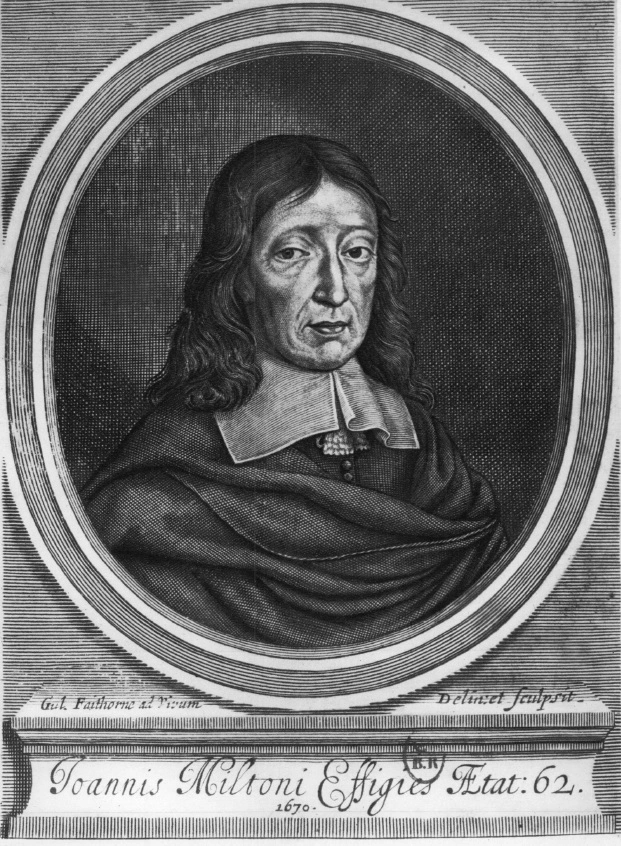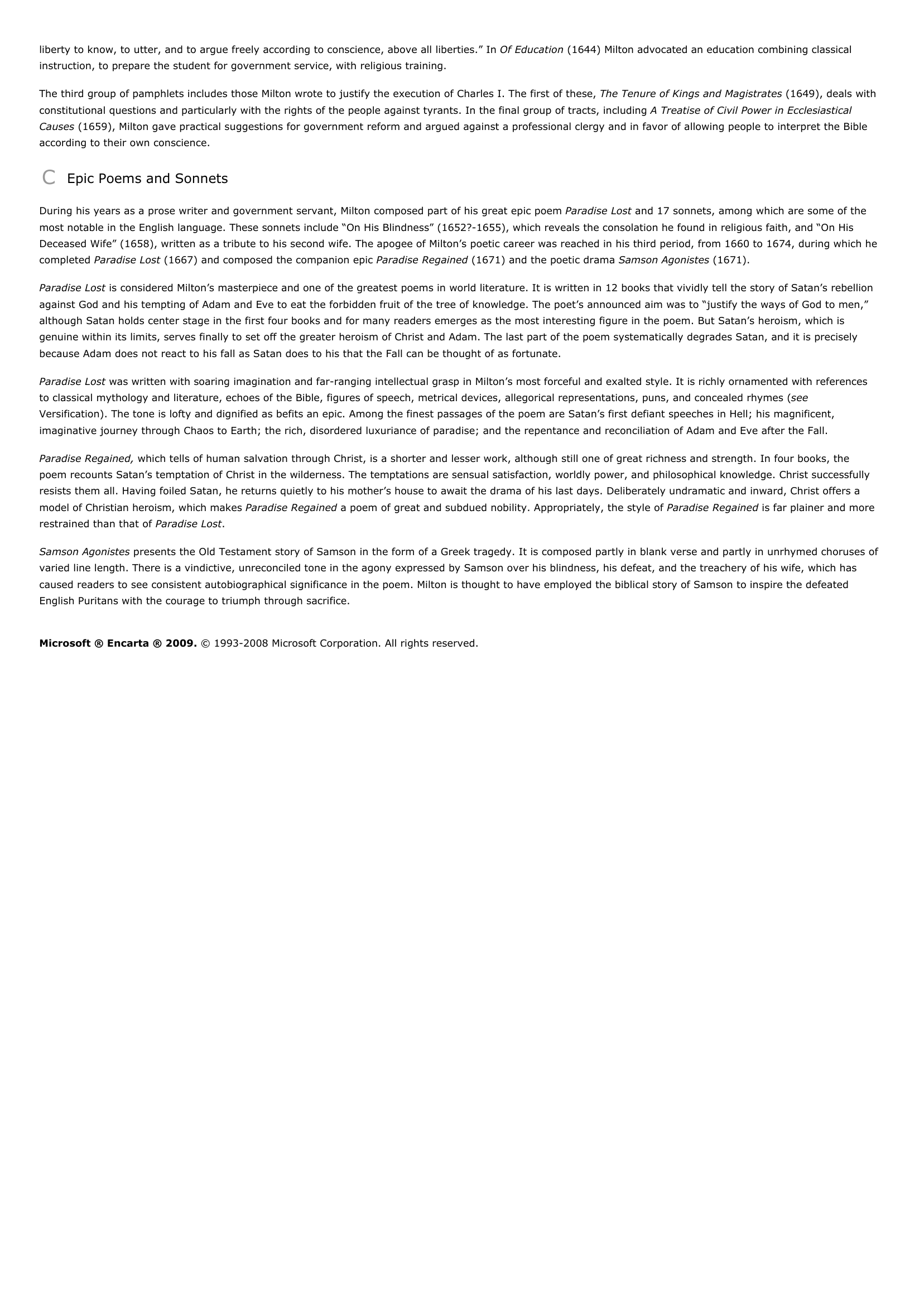John Milton I INTRODUCTION John Milton Seventeenth-century writer John Milton ranks as one of the greatest poets in the history of English literature.
Publié le 12/05/2013

Extrait du document


«
liberty to know, to utter, and to argue freely according to conscience, above all liberties.” In Of Education (1644) Milton advocated an education combining classical instruction, to prepare the student for government service, with religious training.
The third group of pamphlets includes those Milton wrote to justify the execution of Charles I.
The first of these, The Tenure of Kings and Magistrates (1649), deals with constitutional questions and particularly with the rights of the people against tyrants.
In the final group of tracts, including A Treatise of Civil Power in Ecclesiastical Causes (1659), Milton gave practical suggestions for government reform and argued against a professional clergy and in favor of allowing people to interpret the Bible according to their own conscience.
C Epic Poems and Sonnets
During his years as a prose writer and government servant, Milton composed part of his great epic poem Paradise Lost and 17 sonnets, among which are some of the most notable in the English language.
These sonnets include “On His Blindness” (1652?-1655), which reveals the consolation he found in religious faith, and “On HisDeceased Wife” (1658), written as a tribute to his second wife.
The apogee of Milton’s poetic career was reached in his third period, from 1660 to 1674, during which hecompleted Paradise Lost (1667) and composed the companion epic Paradise Regained (1671) and the poetic drama Samson Agonistes (1671).
Paradise Lost is considered Milton’s masterpiece and one of the greatest poems in world literature.
It is written in 12 books that vividly tell the story of Satan’s rebellion against God and his tempting of Adam and Eve to eat the forbidden fruit of the tree of knowledge.
The poet’s announced aim was to “justify the ways of God to men,”although Satan holds center stage in the first four books and for many readers emerges as the most interesting figure in the poem.
But Satan’s heroism, which isgenuine within its limits, serves finally to set off the greater heroism of Christ and Adam.
The last part of the poem systematically degrades Satan, and it is preciselybecause Adam does not react to his fall as Satan does to his that the Fall can be thought of as fortunate.
Paradise Lost was written with soaring imagination and far-ranging intellectual grasp in Milton’s most forceful and exalted style.
It is richly ornamented with references to classical mythology and literature, echoes of the Bible, figures of speech, metrical devices, allegorical representations, puns, and concealed rhymes ( see Versification).
The tone is lofty and dignified as befits an epic.
Among the finest passages of the poem are Satan’s first defiant speeches in Hell; his magnificent,imaginative journey through Chaos to Earth; the rich, disordered luxuriance of paradise; and the repentance and reconciliation of Adam and Eve after the Fall.
Paradise Regained, which tells of human salvation through Christ, is a shorter and lesser work, although still one of great richness and strength.
In four books, the poem recounts Satan’s temptation of Christ in the wilderness.
The temptations are sensual satisfaction, worldly power, and philosophical knowledge.
Christ successfullyresists them all.
Having foiled Satan, he returns quietly to his mother’s house to await the drama of his last days.
Deliberately undramatic and inward, Christ offers amodel of Christian heroism, which makes Paradise Regained a poem of great and subdued nobility.
Appropriately, the style of Paradise Regained is far plainer and more restrained than that of Paradise Lost .
Samson Agonistes presents the Old Testament story of Samson in the form of a Greek tragedy.
It is composed partly in blank verse and partly in unrhymed choruses of varied line length.
There is a vindictive, unreconciled tone in the agony expressed by Samson over his blindness, his defeat, and the treachery of his wife, which hascaused readers to see consistent autobiographical significance in the poem.
Milton is thought to have employed the biblical story of Samson to inspire the defeatedEnglish Puritans with the courage to triumph through sacrifice.
Microsoft ® Encarta ® 2009. © 1993-2008 Microsoft Corporation.
All rights reserved..
»
↓↓↓ APERÇU DU DOCUMENT ↓↓↓
Liens utiles
- Charles Dickens I INTRODUCTION Charles Dickens English author Charles Dickens ranks as one of the most popular writers in the history of world literature.
- William Shakespeare I INTRODUCTION William Shakespeare English playwright and poet William Shakespeare, who lived in the late 1500s and early 1600s, is regarded as the greatest dramatist in the history of English literature.
- Rembrandt I INTRODUCTION Rembrandt (1606-1669), Dutch baroque artist, who ranks as one of the greatest painters in the history of Western art.
- Duke Ellington Duke Ellington (1899-1974), American jazz composer, orchestrator, bandleader, and pianist, considered the greatest composer in the history of jazz music and one of the greatest musicians of the 20th century.
- Children's Literature I INTRODUCTION Kate Greenaway's May Day The delicate skill and graceful simplicity of English artist Kate Greenaway's illustrations delighted children and impressed thinkers, including art critic John Ruskin.























